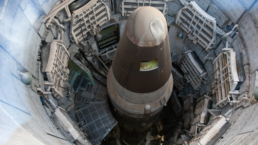“Nothing Can Be Changed Until It Is Faced”
By Norman Solomon, Tom Dispatch
Top American officials in the “national security” establishment are notably good at smooth rhetoric and convenient silences. Their scant regard for truth or human life has changed remarkably little since 1971 when Daniel Ellsberg risked decades in prison to leak the Pentagon Papers to the world. During the years between then and his death six months ago, he was a tireless writer, speaker, and activist.

Most people remember him, of course, as the whistleblower who exposed voluminous official lies about the Vietnam War by providing 7,000 top-secret pages of classified documents to the New York Times and other newspapers. But throughout his adult life, he was transfixed above all by the imperative of preventing nuclear war.
One day in 1995, I called Dan and suggested he run for president. His reply was instant: “I’d rather be in prison.” He explained that, unlike typical candidates, he couldn’t stand to offer opinions on subjects he really knew little or nothing about.
However, for more than five decades, Ellsberg didn’t hesitate to publicly address what he really did know all too much about — the patterns of government secrecy and lies that sustained America’s wars in one country after another, along with the chronic deceptions and delusions at the core of the nuclear arms race. He had personally seen such patterns of deceit at work in the upper reaches of the warfare state. As he told me, “That there is deception — that the public is evidently misled by it early in the game… in a way that encourages them to accept a war and support a war — is the reality.”
And how difficult was it to deceive the public? “I would say, as a former insider, one becomes aware: it’s not difficult to deceive them. First of all, you’re often telling them what they would like to believe — that we’re better than other people, we are superior in our morality and our perceptions of the world.”
Dan had absorbed a vast array of classified information during his years working near the top of the U.S. war machine. He knew countless key facts about foreign policy and war-making that had been hidden from the public. Most importantly, he understood how mendacity could lead to massive human catastrophes and how routinely the key figures in the Pentagon, the State Department, and the Oval Office openly lied.
His release of the Pentagon Papers in 1971 — revealing crucial history about the Vietnam War while it was still underway — exposed how incessant deception got wars started and kept them going. He had seen up close just how easy it was for officials like Secretary of Defense Robert McNamara to suppress doubts about American war-making and push ahead with policies that would, in the end, lead to the deaths of several million people in Vietnam, Laos, and Cambodia. And Dan was haunted by the possibility that someday such deception might lead to a nuclear holocaust that could extinguish almost all human life on this planet.
In his 2017 book The Doomsday Machine: Confessions of a Nuclear War Planner, he highlighted this all-too-apt epigraph from philosopher Friedrich Nietzsche: “Madness in individuals is something rare. But in groups, parties, nations, and epochs, it is the rule.” The ultimate madness of policies preparing for thermonuclear war preoccupied Dan throughout his adult life. As he wrote,
“No policies in human history have more deserved to be recognized as immoral, or insane. The story of how this calamitous predicament came about, and how and why it has persisted for over half a century is a chronicle of human madness. Whether Americans, Russians, and other humans can rise to the challenge of reversing these policies and eliminating the danger of near-term extinction caused by their own inventions and proclivities remains to be seen. I choose to join with others in acting as if that is still possible.”
A Global Firestorm, a Little Ice Age
I don’t know whether Dan liked Italian philosopher Antonio Gramsci’s aphorism about “pessimism of the intellect, optimism of the will,” but it seems to me an apt summary of his approach to the specter of nuclear annihilation and an unfathomable end to human civilization. Keeping his eyes relentlessly on what few of us want to look at — the possibility of omnicide — he was certainly not a fatalist, yet he was a realist about the probability that a nuclear war might indeed occur.
Such a probability now looms larger than at any other time since the Cuban missile crisis in October 1962, but its most essential lessons seem to have been lost on President Biden and his administration. Eight months after that nearly cataclysmic faceoff six decades ago between the United States and the Soviet Union, President John Kennedy spoke at American University about the crisis. “Above all,” he said then, “while defending our own vital interests, nuclear powers must avert those confrontations which bring an adversary to a choice of either a humiliating retreat or a nuclear war. To adopt that kind of course in the nuclear age would be evidence only of the bankruptcy of our policy, or of a collective death wish for the world.”
But Joe Biden has seemed all too intent on forcing his adversary in the Kremlin, Vladimir Putin, into just such “a humiliating retreat.” The temptation to keep blowing a presidential bugle for victory over Russia in the Ukraine war has evidently been too enticing to resist (though Republicans in Congress have recently taken a rather different tack). With disdain for genuine diplomacy and with a zealous desire to keep pouring huge quantities of armaments into the conflagration, Washington’s recklessness has masqueraded as fortitude and its disregard for the dangers of nuclear war as a commitment to democracy. Potential confrontation with the world’s other nuclear superpower has been recast as a test of moral virtue.
Meanwhile, in U.S. media and politics, such dangers rarely get a mention anymore. It’s as if not talking about the actual risks diminishes them, though the downplaying of such dangers can, in fact, have the effect of heightening them. For instance, in this century, the U.S. government has pulled out of the Anti-Ballistic Missile, Open Skies, and Intermediate-Range Nuclear Forces arms-control treaties with Russia. Their absence makes nuclear war more likely. For the mainstream media and members of Congress, however, it’s been a non-issue, hardly worth mentioning, much less taking seriously.
Soon after becoming a “nuclear war planner,” Dan Ellsberg learned what kind of global cataclysm was at stake. While working in the Kennedy administration, as he recalled,
“What I discovered, to my horror, I have to say, is that the Joint Chiefs of Staff contemplated causing with our own first [nuclear] strike 600 million deaths, including 100 million in our own allies. Now, that was an underestimate even then, because they weren’t including fire which they felt was too incalculable in its effects. And of course, fire is the greatest casualty-producing effect of thermonuclear weapons. So, the real effect would have been over a billion not 600 million, about a third of the Earth’s population then at that time.”
Decades later, in 2017, Dan described research findings on the “nuclear winter” that such weaponry could cause:
“What turned out to be the case 20 years later in 1983, confirmed in the last 10 years very thoroughly by climate scientists and environmental scientists, is that that high ceiling of a billion or so was wrong. Firing weapons over the cities, even if you called them military targets, would cause firestorms in those cities, like the one in Tokyo in March of 1945, which would loft into the stratosphere many millions of tons of soot and black smoke from the burning cities. It wouldn’t be rained out in the stratosphere, it would go around the globe very quickly, and reduce sunlight by as much as 70 percent, causing temperatures like that of the Little Ice Age, killing harvests worldwide and starving to death nearly everyone on Earth. It probably wouldn’t cause extinction. We’re so adaptable. Maybe 1 percent of our current population of 7.4 billion could survive, but 98 or 99 percent would not.”
Facing the Hell of Thermonuclear Destruction
In his book The Doomsday Machine, Dan also emphasized the importance of focusing attention on one rarely discussed aspect of our nuclear peril: intercontinental ballistic missiles, or ICBMs. They are the most dangerous weapons in the arsenals of the atomic superpowers when it comes to the risk of setting off a nuclear war. The U.S. has 400 of them, always on hair-trigger alert in underground silos scattered across Colorado, Montana, Nebraska, North Dakota, and Wyoming, while Russia deploys about 300 of its own (and China is rushing to catch up). Former Defense Secretary William Perry has called ICBMs “some of the most dangerous weapons in the world,” warning that “they could even trigger an accidental nuclear war.”
As Perry explained, “If our sensors indicate that enemy missiles are en route to the United States, the president would have to consider launching ICBMs before the enemy missiles could destroy them. Once they are launched, they cannot be recalled. The president would have less than 30 minutes to make that terrible decision.” So, any false indication of a Russian attack could lead to global disaster. As former ICBM launch officer Bruce Blair and former vice chair of the Joint Chiefs of Staff General James Cartwright wrote: “By scrapping the vulnerable land-based missile force, any need for launching on warning disappears.”
During an interview with me in 2021, Dan made a similar case for shutting down ICBMs. It was part of a recording session for a project coordinated by Judith Ehrlich, co-director of the Oscar-nominated documentary “The Most Dangerous Man in America: Daniel Ellsberg and the Pentagon Papers.” She would go on to create an animated six-episode “Defuse Nuclear War Podcast with Daniel Ellsberg.” In one of them, “ICBMs: Hair-Trigger Annihilation,” he began: “When I say that there is a step that could reduce the risk of nuclear war significantly that has not been taken but could easily be taken, and that that is the elimination of American ICBMs, I’m referring to the fact that there is only one weapon in our arsenal that confronts a president with the urgent decision of whether to launch nuclear war and that is the decision to launch our ICBMs.”
He went on to stress that ICBMs are uniquely dangerous because they’re vulnerable to being destroyed in an attack (“use them or lose them”). In contrast, nuclear weapons on submarines and planes are not vulnerable and
“can be called back — in fact they don’t even have to be called back, they can… circle until they get a positive order to go ahead… That’s not true for ICBMs. They are fixed location, known to the Russians… Should we have mutual elimination of ICBMs? Of course. But we don’t need to wait for Russia to wake up to this reasoning… to do what we can to reduce the risk of nuclear war.”
And he concluded: “To remove ours is to eliminate not only the chance that we will use our ICBMs wrongly, but it also deprives the Russians of the fear that our ICBMs are on the way toward them.”
While especially hazardous for human survival, ICBMs are a humongous cash cow for the nuclear weapons industry. Northrop Grumman has already won a $13.3 billion contract to start developing a new version of ICBMs to replace the currently deployed Minuteman III missiles. That system, dubbed Sentinel, is set to be a major part of the U.S. “nuclear modernization plan” now pegged at $1.5 trillion (before the inevitable cost overruns) over the next three decades.
Unfortunately, on Capitol Hill, any proposal that smacks of “unilateral” disarmament is dead on arrival. Yet ICBMs are a striking example of a situation in which such disarmament is by far the sanest option.
Let’s say you’re standing in a pool of gasoline with your adversary and you’re both lighting matches. Stop lighting those matches and you’ll be denounced as a unilateral disarmer, no matter that it would be a step toward sanity.
In his 1964 Nobel Peace Prize speech, Martin Luther King Jr. declared, “I refuse to accept the cynical notion that nation after nation must spiral down a militaristic stairway into the hell of thermonuclear destruction.”
It’s easy to feel overwhelmed and powerless on the subject. The narratives — and silences — offered by government officials and most media are perennial invitations to just such feelings. Still, the desperately needed changes to roll back nuclear threats would require an onset of acute realism coupled with methodical activism. As James Baldwin wrote: “Not everything that is faced can be changed; but nothing can be changed until it is faced.”
Daniel Ellsberg was accustomed to people telling him how much he inspired them. But I sensed in his eyes and in his heart a persistent question: Inspired to do what?
Norman Solomon is co-founder of RootsAction.org and executive director of the Institute for Public Accuracy. His books include War Made Easy, Made Love, Got War, and most recently War Made Invisible: How America Hides the Human Toll of Its Military Machine (The New Press). He lives in the San Francisco area.
Recent Posts
The Rage Of Billionaires And The Frenzy To Stop Zohran Mamdani From Becoming New York’s Mayor
June 30, 2025
Take Action Now The constellation of forces now regrouping with a vengeance includes titans of Wall Street, enormous real estate interests,…
It’s Not Just The Cities. Extreme Heat Is A Growing Threat To Rural America.
June 28, 2025
Take Action Now The urban heat island sits in a rural heat ocean.By Umair Irfan, Vox Summer has officially begun with a blast of scorching…
Mamdani’s Massive Victory Should Show Democrats Where The Party’s Future Lies
June 27, 2025
Take Action Now NYC mayoral candidate Zohran Mamdani has thrown the drowning Democratic Party a life vest. Will its leaders use it?By Sam…
India Walton’s Advice For Zohran Mamdani
June 26, 2025
Take Action Now “I think that for him, the race ’til November needs to be staying on message—we can’t start to water it down…




